
This photograph was taken by Kurdish guerrillas of the HPG, the armed force of the PKK, which has been fighting against the government of Turkey since 1984. I doubt that anyone knows exactly where this picture was taken; anyone, that is, except the guerrillas who took it. I found this photo recently--this and the others which follow--deep in the website of the HPG.
Readers should remember this about Anatolia, the land mass now occupied by the Republic of Turkey: it is a heap of ruins, a treasure house of history, a place whose secrets archaeologists have scarcely begun to uncover. Only in the last ten years, for example, have archaeologists uncovered artifacts in the town of Hakkari, capital of the province of the same name, which belong to a people that the scientists cannot yet identify. Probably they are ancestors of the Kurds who have always lived there. Clearly there is more to the story of the people and civilizations of these mountains than has been discovered so far. And that's why the photograph above is potentially of such interest, especially to the Kurds.
These pictures represent, I believe, a new phenomenon in this high tech age: rebels, outlaws, guerrillas (officially "terrorists" to the Turkish govt., which forbids calling them anything else) hiding out in some of the remotest, least explored mountains on earth, carrying digital cameras in their pockets and using them to document the wonders of the world they inhabit. And one of those wonders is this tunnel.
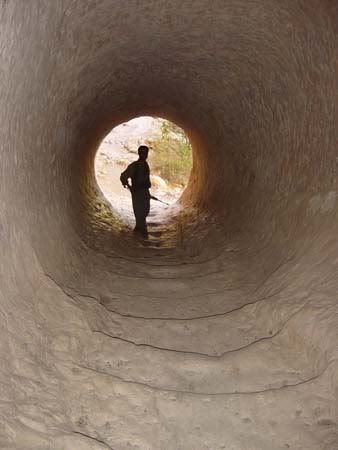
Who built it, and when? Why did they go to all the trouble to cut through solid rock and gain access to this remote canyon? (By the way, we know that it's remote--very remote--because otherwise the PKK guerrillas wouldn't be there.) I am no expert on this area--probably situated in the mountains of Bohtan: Cudi Dagh (pron. Judi Daah) and Gabar Dagh, near the town of Sirnak--but I have read a substantial amount of the travel literature, and I know of no Western traveler who has explored this area and published pictures like these. Freya Stark did pass this way (on a mule) in the 1950s, but she took a route further north, close to the present-day motor road that runs west from Hakkari to Sirnak and Cizre, on the Tigris. In the 19th century Gertrude Bell explored the south slopes of Judi Dagh looking for the shrine and tomb of Noah (also, as we will see, photographed by the PKK), but she didn't penetrate the mountains themselves. And in 1843 Asahel Grant, M.D., of Utica and Waterville, New York, rode into the western, more settled side, to meet Bedr Khan Bey, the Kurdish emir of Bohtan and progenitor of the Bedirhan clan who have been so prominent in modern Kurdish history.
There was, however, one group of Westerners which passed directly through the very heart of these same mountains. Their passage was hardly a secret and certainly not easy. They were the Ten Thousand Greeks, stranded mercenaries trying to make their way home from the Battle of Cunaxa, near Babylon, in 401 B.C. Their journey is described in the Anabasis of Xenophon.
When they first encountered the villages of the mountain people, the Greeks left them untouched, in hopes that the natives would let them pass unhindered. Their hopes were disappointed. In the seven days it took them to traverse the mountains of the Karduchoi, generally thought to be the antecedents of the Kurds, the Greeks suffered more than in all the battles they had previously fought. The Karduchoi were everywhere, rolling great rocks down upon them, harassing their rear and flanks, shooting at them with bows six feet long and powerful enough to pierce armor with their arrows. It was, as Xenophon describes it, a hell on earth, complete with thunderstorms, rain, and snow: a famous episode in a justifiably famous book. Up to now I'm not aware that anyone has published evidence of the Karduchoi and their society. With these photographs I believe that the guerrillas of the PKK have done just that.
Judging from the order of the photos, the tunnel above appears to lead to this:
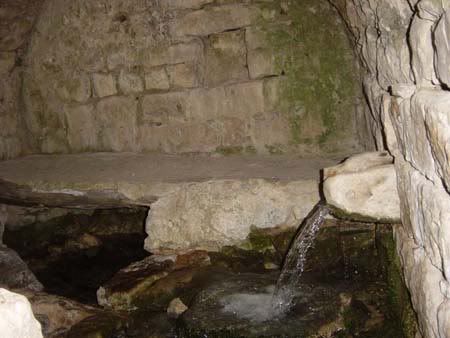
It's a cave, obviously, and a spring of some kind, with water emerging from a spigot hewn from the rock. Notice also the stone work. Obviously this is old, but is it ancient enough to be the work of the Karduchoi? The next images show these:

Which is a detail of this:
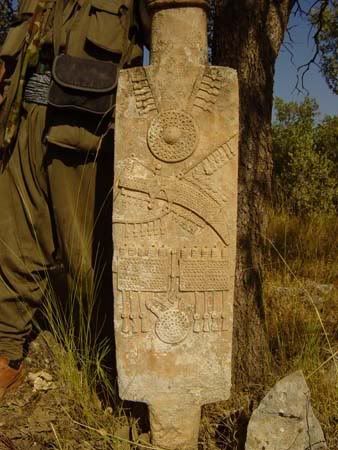
The figure on the left of the stele is a PKK fighter with his weapon. Included in this series are the following images carved from stone:
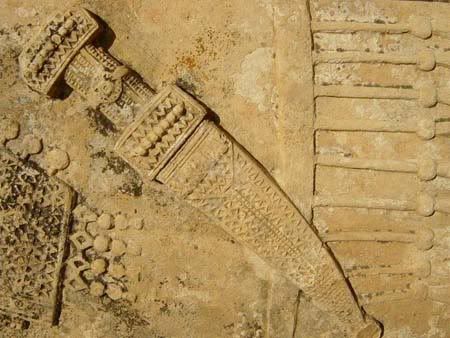
More detail of the dagger on the grave stele. Note that it's virtually the same style of ritual dagger worn by modern Kurd and Arab tribesmen. Also, animals. A snake:

Dogs, and judging by their curved tails, possibly Salukis:

Ducks?
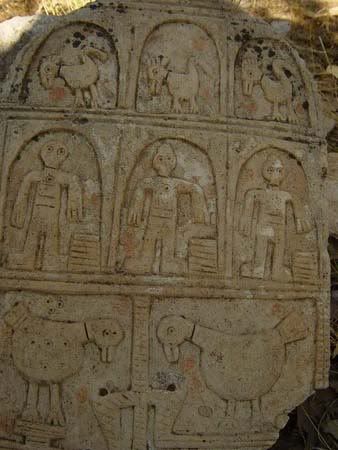
A mounted king:
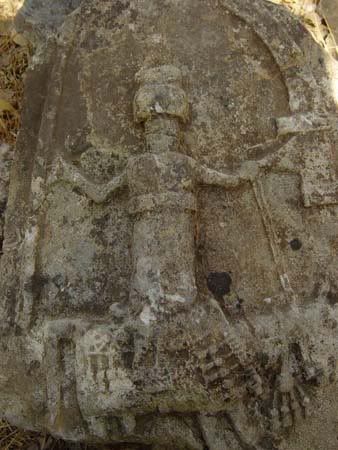
This should provide enough excitement for anyone, especially those who get seduced by Indiana Jones movies. But Kurdish nationalists, I would think, might especially want to take note. If I'm wrong, and these artifacts have already been thoroughly catalogued by archaeologists, then I will gladly retreat into obscurity. But I think this is fascinating stuff. And the only people who really know about it are the PKK guerrillas.
Labels: Gordon Taylor
Although I am not a specialist in Mesopotamian archaeology, based on the recent hstory of the area it is probable that the artifacts imaged have not been scientifically documented. Generally, this requires a survey team conducting detailed mapping of the objects found in situ (original position/location). I suspect that there was little interest in documenting these items during the Ottman Empire, and I highly doubt Saddam Huseyin would have conducted or sponsored such an activity.
After reading the article, I wondered if the Kurds would allow an archaeologist and team in to conduct such a survey? With all of the current political/military tension, it would be a dangerous task but no less important that documenting the exstensive archaeological record from China's Three Gorges Dam? Wonderful article. Well done!
Hevallo on 10/29/2007 5:56 PM:
dear anon, if you are serious and have the funding I'm sure that the Kurds would welcome a team to investigate these items further. It might be a tall order at this particular moment as our friends have rather a lot on thier plate at the moment but if you or others are serious send me an email and I could point you in the right direction for further enquiries.
samarkeolog on 10/29/2007 7:04 PM:
Yes, I'm not sure this is quite the right time. In addition, there is the question of whether archaeologists would volunteer, even if it were secure.
Some have worked in or with Iraq, Iraqi institutions and/or Iraqi archaeologists, historians, etc. since the invasion.
Some others, however, have questioned whether the profession should be cooperating with the post-invasion authorities (presumably, also questioning cooperation with pre-invasion authorities).
I'm not sure how they would judge cooperation with the Kurdish Regional Government.
Even if they deemed it democratic and representative, according to Human Rights Watch, its security forces torture detainees. (http://hrw.org/english/docs/2007/07/03/iraq16319.htm)
As for the PKK, amongst other things, according to Amnesty International, it uses child soldiers. (http://web.amnesty.org/library/Index/ENGMDE010032001?open&of=ENG-2MD)
Some archaeologists might refuse to work with them for the same reasons they refuse to work with the Turkish government.
Hevallo on 10/29/2007 8:10 PM:
Samark,
I'm quite used to challenging a lot of Turkish origin psychological warfare stuff, like PKK killing civilians, eating babies, etc etc...but this is the first time I've seen the 'regiments of child soldiers line' I must say. But I'm afraid I cannot let it go without comment.
I have met young people who have joined the organisation at a young age and perhaps, when seen through the eyes of someone who grew up in untroubled times and in a peaceful part of the world it might seem, unusual or unfair. But I'm able also to see from the other side and know that the Kurds have suffered unmentionable crimes and many of the youngsters I've come across have harrowing stories to tell of their lives BEFORE joining the PKK. Of village burnings and horrific torture and killings to their families. Many escaped the repression and joined willingly.
I little bit of background and context to these more sensationalist annoucements would at least try to understand why someone so young would join an armed group.
I have also to say that I have never in all my time working on the Kurdish issue come across any evidence of 'child regiments'. I think that one is from the Turkish Psycho department.
samarkeolog on 10/29/2007 8:36 PM:
I know that they've suffered unmentionable crimes - and I've been to a few of the thousands of burned villages - and I understand that some, perhaps many, could want to take up arms; still, they are children - the ones discussed were not seventeen-year-olds, or even fifteen-year-olds.
Amnesty International is not the "Turkish Psycho department" and it has not been tricked by it. Even if, as you contend, there were no "child regiments", you concede that "young people" of a "young age", "youngsters", are in the PKK. Child soldiery is wrong and even if the children - even if all of the children - believe they want to fight, the adults should not accept it. The PKK's acceptance of child soldiery and use of child soldiers in the war is immoral.
Gordon Taylor on 10/29/2007 9:38 PM:
Hevallo:
Thanks for your comment. Of course these are PKK photos, so I have no control over who copies them. I will write to you c/o your blog; I have a couple of questions to ask.
Anonymous and Hevallo:
I can state quite definitely that these photos were taken IN TURKEY. So Saddam Hussein and the KRG will have nothing to do with their past or future investigation.
I am pretty sure I have been in that cave pictured above. It is in the area of Göreme in Capadocia.
http://en.wikipedia.org/wiki/G%C3%B6reme
http://en.wikipedia.org/wiki/Cappadocia
There are even complete cities with six, seven levels for thousands of people underground.
It is not kurdish heartland though. That is more to the east around Van and south to Hakkari. The mountains there are more rough and not so easy to dig in. But there are more natural caves there.
samarkeolog on 10/30/2007 8:44 AM:
My last post seems to have been lost in the ether on my Cypriot connection. Sorry, I forgot that you'd said these were from the Bohtan Mountains near Sirnak and just followed the Saddam Hussein reference unthinkingly.
You would still have the question of working with or under the PKK and, on top of that, you would have to get a licence from the Turkish government, which may not be too keen on you documenting this cultural heritage, particularly if you call it Kurdish cultural heritage, made by their ancestors (or simply being in the area and seeing too much). After both of those were satisfied, you would have to consider whether the local community were sufficiently free to be able to consent to the project.
Gordon/Samarkeolog:
Thank you for the clarification. I did pull up a map later to see that the Bohtan Mtns. Sorry about that Samarkeolog! And, thank you for your insights into what might be involved. I do know a group of archaeologists who specialize in emergency documentation (they walked in front of a firestorm to document Native American sites about to be destroyed) but I doubt they have ever been involved in documenting during gun battles or artillery barrages.
samarkeolog on 10/30/2007 11:36 AM:
No problem - I was easily led, as I'd been talking about archaeologists' cooperation with the Iraqi authorities at the time I was writing - and in an earlier draft I had tried to talk about the (abstract) example of archaeologists cooperating with the (central) Provisional Coalition Authority.
I was going to say that you would be hard-pressed to find archaeologists working in those conditions, but I remember friends and colleagues talking about work during the Israel-Lebanon war, but this might be a little too close for comfort even for them...
Gordon Taylor on 10/30/2007 2:34 PM:
Some responses:
b., This is not Goreme. I, like millions of tourists, have been to Goreme, and this is nothing like it. The online album from which this is extracted states clearly that it was taken in the area of Gabar Dagi, which is near the town of Sirnak.
Samarkeolog: Like Hevallo, I'm not aware of any widespread use of "child soldiers" in the ranks of the PKK. Yes, they have many young people with them, but these are of the age when, like it or not, soldiers are normally sacrificed: late teens, early twenties. Pre-teens may be in there somewhere, but if they are they don't show up in any pictures on the HPG website. And given the extremely rough conditions in which these guerrillas live--they have to walk everywhere, remember, over rugged mountains, sleeping in caves, subsisting on the meagrest of rations--I fail to see what use child soldiers would be to them. The very latest clashes, for example, have been in Tunceli, aka Dersim, which is hundreds of miles from the Iraqi border. I repeat: HUNDREDS.
Hevallo on 10/30/2007 6:59 PM:
Samark, I can really say that I have not come across, 'child soldiers' in the PKK. Young people, yes, but child soldiers, no. And do not believe that even if there were some 'children' in a camp that they would be allowed to go to out for actual fighting. I'd like to see Amnesty Internationals evidence for this. I would not have all the faith in Amnesty International if I were you either. AI's desperate need to be impartial has led it to some very dodgy positions in regards to the Kurdish issue in my view.
Mizgîn on 10/31/2007 10:05 AM:
I am always amused by the child soldier claim.
You have Kurdish teenagers who have witnessed and lived the repression in their villages. The males in their families rotate in and out of prison as political prisoners. They see that there are no basic services provided to their villages because they are Kurds. Or maybe they were forcibly driven from their villages with their families and the villages were destroyed by the regime. They become shanty-dwellers in the larger cities and the families have little hope of income because they are all farmers or have always had livestock to raise for a living.
In the cities, there is more repression because this was the purpose of the forced displacement--to gather Kurds in close areas where the population is more easily controlled by the regime. And I haven't gone into the personal atrocities that the families have suffered as a result of the brutality, but you can bet this also makes an impression on Kurdish youth.
Precious few complain if the Turkish military comes along and brutalizes (even to the point of murder) of Kurdish infants, children, and youth, but everyone goes wild if one of these teens takes up an AK and goes to the mountains. If a Kurd is brutalized by an oppressive and illegitimate regime (remember now, the regime in Ankara TODAY is a direct result of a military coup), then as far as I am concerned that Kurd--no matter what age--has the legitimate right to take up arms in defense against the regime.
Now, when the local jandarma notices that a teen is gone from a family, what should the family tell the jandarma? That their son or daughter joined PKK? What do you think would happen to such a family? Better for them that they say "PKK kidnapped our son/daughter," than that they get more abuse by this evil regime.
If "children" are old enough to be brutalized by the Turkish regime, then they're old enough to fight against it.
Of course, the infant that was murdered recently in Çemê Karê, in Sêrt, never had the chance to become a teen who could take up an AK. But then, you don't hear anyone getting their panties twisted in knots over that TSK murder, do you?
It's pretty hypocritical that murdered infants don't get the attention that the child soldier claim gets.







Fantastic stuff. I tell my students that every advance in technology -- especially forensic and information technology -- is an advance for historians. This is exactly the kind of thing I'm talking about.
That is some neat stonework, indeed.